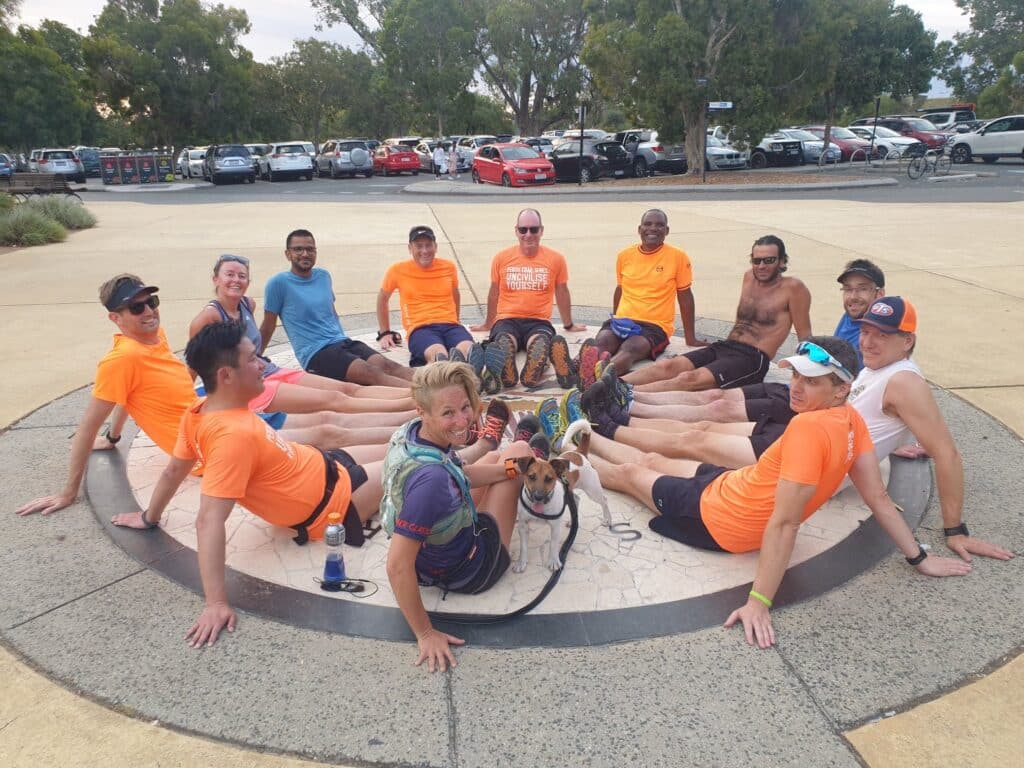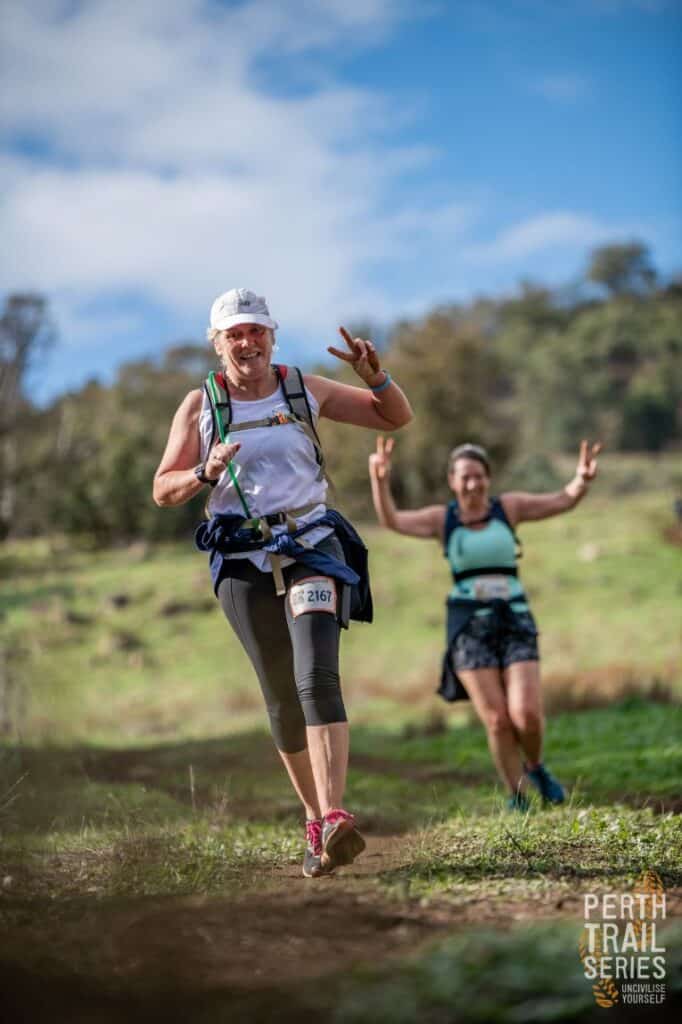I can feel the twitch in my legs, and we’re all watching the clock. We get this way every week at this time. We make sure we’ve got a clean orange shirt. After a full-on day, it’s the best way to empty the mind. We’re about to get moving with an awesome bunch of humans. Welcome to the Thursday night social run!
We meet at 5.55 p.m. for a 6.00 start. You’ll know you’re in the right place when you spot us—and you will. You’ll have no trouble seeing the group clad in bright orange amongst the magnificent backdrop of eucalyptus trees, the stunning river, and the city skyline.
You’ll hear the excited buzz of chatter as we greet each other. There are so many regular faces that show up on Thursday nights. We’ve been doing it since 2015. But there are always new runners, joining the group for the first time, so I introduce myself to anyone who is new to the group and run through the basic concepts: We stay together in a group. We stick to the trails. Each week we’ll go a different route, which depends on who’s leading. Yes, we’ve got someone leading, and the rest of us fall in behind. We’ve got this concept of “sheepdogging”, where the front of the pack loops back and collects those in the back. The sheepdogs will log close to ten kilometres; those in the back of the pack will likely clock eight. If we make a slight turn, it’s everyone’s job to look back for other runners and make sure they can see where we’re heading. We pause and point the direction so the back of the pack can follow along. When we know the runners behind us have spotted us, we get back to trotting. If we get to a turn or junction, we can either sheepdog or welcome the stop. Finally, and most importantly, we’re a friendly bunch. We welcome all runners of all abilities and provide a level of accountability with no pressure. Just fun, running, and an awesome community.
I always finish this spiel with three key things:
- Smile. A smile is the most important part of your form. Let’s have fun!
- Name game. We go around the circle, and everyone says their name.
- Photo. We capture a photo of everyone, excited to head off on a Thursday night.
With the formalities out of the way, it’s time to head off. This is when the chatter kicks in, as we naturally pair up down the trail. We can begin our weekly check-in, find out what’s been happening individually throughout the week. We share jokes or stories from the office. We connect, because we’ve taken the time to get to know each other. We also chat about upcoming races, places we’re going, the shoes we’re wearing. Anything goes.
If you’re after the mind-emptying kind of run tonight, don’t worry. You can choose to listen to the birds or the wind blowing.
Unofficially, this is where we learn something called trail etiquette. The Thursday-night runs are a great intro into what this community is all about. Being trail runners, we’ve got a big responsibility.
We’ve already learned that a smile is the most important part of form, the names of people who are with us, and how to make sure everyone stays together. Next we’ll learn that now we know them, they’ve become our responsibility. We look after each other on the trails. You may find yourself in a situation—not necessarily on a Thursday, but at some point in your trail-running lifetime—when someone is in pain, maybe crying or otherwise in distress. As a trail runner, you must stop and help them. The best runners in the group are the ones who look after each other, not the ones who are fastest or cover the most distance.
If you come out to an event, it’s your responsibility to know the course you’re about to run. We send out maps and GPX files. We give you directions on how to get there, and it’s your job to know where you’re going. It’s our job to mark the course so you can follow it, but you must pay attention and show up on time.
On a Thursday night, we also learn about out’n’backs. We don’t wear our headphones. We practise passing etiquette, calling out “Passing!” on the left and doing so only when safe. If you feel someone breathing down your neck, call out “Would you like to pass?” and then let them go by. When you’re passing, say “You’re looking really good!” and chuck them a high-five as you carry on, feeling spritely.
When someone new joins the group, they usually ask me how much I run, what I’m training for, where I go. Why am I so passionate about it? Well, I have a number of standard answers, but here’s a story I’ve never shared. I want to tell you about a day when I skipped a run.
We used to run around the camp’s perimeter. We had a small circuit outside our own compound, and we would exit the gate to a separate compound, onto a larger circuit. It was gravel, and it was flat, but it was a place where we could forget we were at war. Where we could be outside without a weapon or a vest.
Yes, there were watchtowers, with guards and guns. Yes, we were in uniform. There was dust and the smell of burning rubbish in the air. But getting to run outside on an uneven surface, to stretch my legs, has always brought a smile to my face. A sense of freedom—freedom from work, from the mission, from the mind. Running is like that.
When we were running, we’d talk about what we would be doing if we weren’t in Afghanistan, who we had waiting for us at home. We all had someone waiting. We always do, even though at times it feels easier to be strong and independent, than to acknowledge how interconnected we all are. How each action we take causes another action.
Most weeks we could make a phone call to get updates from the outside, but those weekly phone calls home felt strained. Hearing about the normal day-to-day stuff kept getting harder to relate to. And so the run became a great time to talk about that stuff, the questions that arise: Who have I become? Who was I before? A run leads you back to your sense of who you are.
We’d unwind and talk about our day as we ran. We did a lot of that. We took the frustrations out of the workplace and left them on the perimeter. We’d talk about everything. The exciting projects we were immersed in and the progress we were making. The cultural barriers we faced. What we ate for lunch.
We talked about other runs, cool races that were popping up, different places in the world that we’d been running through and where we’d like to go. I cut out pictures from magazines and hung them on the plywood walls. I wanted to feel it all again—the electric, connected oneness that you reach when you combine nature and movement. Out on a trail run.
But then there was the day when I skipped a run…I’d just returned from a three-day mission in the remote northeast region. I still had all my post-mission jobs to go through before heading out on the next mission in a few days. Empty rucksack. Wash clothes, especially socks. Clean my boots, my M4, my M9. Things got so dusty. Take a shower. Check in with my troops. Find out what had been happening back at camp.
“You coming for a run with us today?” She checked in. We loved Friday runs. Wrapping up a week in a never-ending countdown to returning home. I’d already been there over 200 days!
Those little milestones are worth celebrating, but I said something like, “Not today. We’ll catchup on the next one. You know how it is. The mission!”
There weren’t many runners around the camp, so our small group always looked after each other, from ordering stuff online to collecting it when it arrived. One of my additional jobs was to drive out to the airstrip to meet the plane. I’d spot names on boxes as we unloaded, and I’d get so excited! There were little things, like spotting a favourite cookie and bringing it to your friend at the end of a fourteen-hour shift. We all had different schedules, different jobs, different ranks, different missions. Different backgrounds, all brought together by running.
Shots. Loud, echoing. Warning sirens blared. It happened just outside our compound. Outside the gate, beyond the camp’s perimeter. On the gravel, on the flat. On a run. Bang! Loud. Echoing. Four runners were shot down on a Friday afternoon by a guard wearing a uniform that we worked with everyday.
Out there, life was always moment to moment. We always said, “You never know when it’s your time to go.” Followed by a qualifying statement this time, “At least they died doing something they loved.”
On that day, two people died. That was the day I skipped a run.
On that day, there was no more running crew, and I became the one waiting. I no longer had the opportunity to go along the perimeter, to exit the gate, to enter that separate compound onto a larger circuit. I was no longer allowed on the gravel, on the flat, and I no longer had my running mates. No more space to forget we were in war.
Those remaining days dragged; I grabbed hold of any mission that I could. The longer the drive, the better. The more remote, the better. The only thing that ticked on was time, because my legs weren’t ticking over on the trail. I’d skipped a run that day without knowing how long it would be before I got back out there.
And that’s how it is sometimes. It’s hard to get back into it. Back from Afghanistan, I’ve gone through other periods where I didn’t feel like going for a run, but no matter what, I always made the time to show up on a Thursday night. I finish every run feeling grateful. And no matter what, I always feel so much better afterwards, so much better than if I’d missed the run.
Stu, one of our regular Thursday night runners says, “The release a Thursday night social brings is awesome, and the benefit of an hour with good, like-minded people cannot be underestimated. We’re just people who enjoy the sport. No elitism, no show ponies—just runners.”
Here is a set of basic guidelines for trail running, applicable in Afghanistan, Australia, or anywhere else you’re heading out for a run.
A few good practices:
- Tell someone where you are going and how long you expect to be on the trail.
- Carry fewer problems and worries so your feet stay light.
- Bring awareness to the breath and to the present moment.
- Connect to your sense of self.
- Have a prepare-for-anything attitude and a sense of adventure.
- Check in with the people you’re running with and—this is essential—look after each other.
- Allow yourself to be on the trail, and know that speed/times may be longer than you reckon they should.
And a checklist of practical things to bring along:
- More water than you think you need (Sooner or later, you’ll end up investing in a hydration pack, but you don’t need to at the beginning.)
- A charged phone
- A GPS watch to track where you are
- A basic first aid kit
- Some food, if it’s a run of 90 minutes or more
- A head torch if you’re going late in the day
- Trail shoes: Trail shoes have more aggressive tread patterns with grippy bottoms. Most trails we run are a mixture of dirt, sand, and clay-type surfaces. Rocks and pea gravel are very common in the hills of Western Australia.




